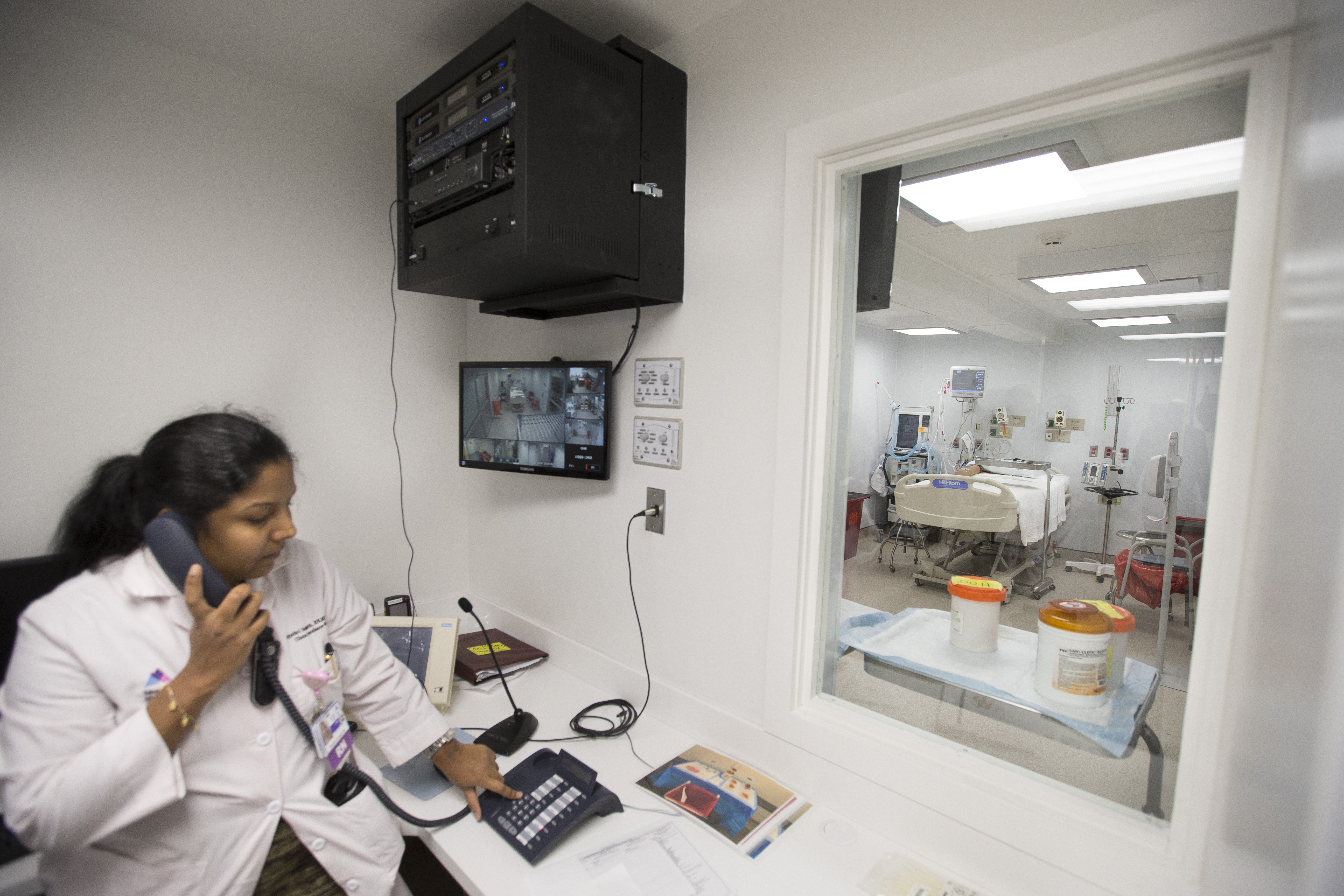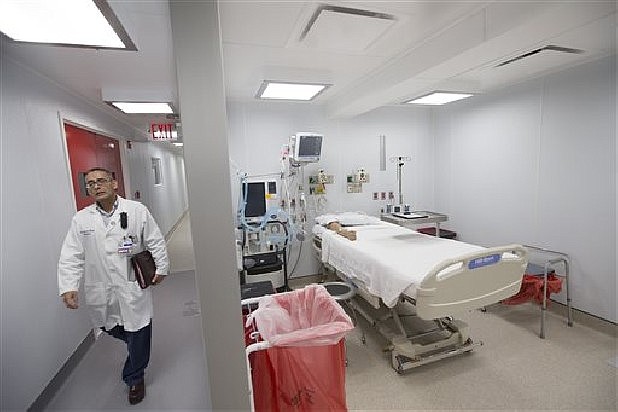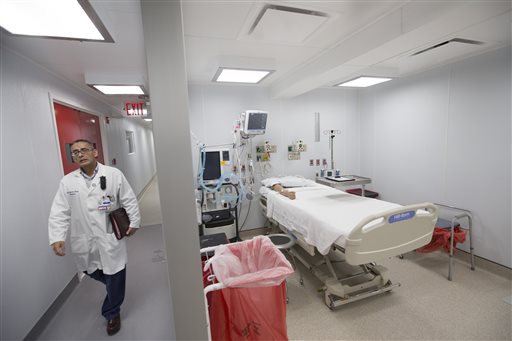NEW YORK - What does it take to Ebola-proof a hospital?
Over the past few months, U.S. medical centers have spent millions of dollars putting together a plan to treat patients with the scary, but extremely rare disease.
To a large extent, it has been an exercise in improvisation.
In Newark, New Jersey, a hospital dealing with a space-crunch and staff anxiety moved its Ebola operation out of its main building and into a mobile medical shelter ordinarily used during natural disasters. In Dallas, Texas, three hospital systems pooled resources to create a treatment center in a defunct intensive care unit sitting empty since the spring. In Kansas, a hospital hastily built walls and hung plastic sheeting to create an isolation suite. A New York City hospital put together one unit, decided it wasn't optimal, and is finishing work on a replacement.
Federal officials have said they're trying to identify up to 20 hospitals around the country as Ebola referral centers. U.S. Centers for Disease Control and Prevention inspection teams have visited nearly 30 hospitals to offer advice and see if they have the right safeguards in place to treat patients with Ebola.
A U.S. House subcommittee held a hearing on Ebola preparedness Tuesday. A U.S. Senate committee had another hearing on the subject planned for Wednesday. President Barack Obama has asked Congress for $6.18 billion to fight Ebola globally, some of which could be used to strengthen domestic health defenses.
There is no tried-and-true way to build an Ebola ward, but the administrators cobbling them together have been guided by a few key principals gleaned from clinics in Africa and the few full biocontainment facilities in the U.S.
At a minimum, treatment units need a "hot" zone where patients can be isolated, a "cold" zone kept free of anything that might be tainted with the virus, and a "warm" zone where workers can peel off protective gear while spotters watch for any small break in protocol. Most hospitals have also preferred to locate their Ebola treatment areas far, far from other patients.
Here is a look at some of the solutions that they've come up with in three months of frenzied planning:
THE MASH UNIT
The first few times patients turned up at Newark's University Hospital with symptoms that could be caused by Ebola, "we were bordering on hysteria," said Dr. Greg Sugalski, chief of the emergency department.
There was confusion about safety protocols. The emergency room was too cramped; It had two rooms for isolating patients, but no adjacent space for health care workers to get in and out of protective gear. Plus, other patients were freaking out.
"There was a lot of gawking," Sugalski said. "People were walking out, not wanting to be near someone who might have Ebola."
The solution was sitting in storage: A Western Shelter GK-1935 medical tent system - sort of an emergency room in a box that the hospital had previously deployed after Hurricane Sandy.
It quickly became a pop-up isolation unit, erected inside a vacant, unfinished floor in the hospital's ambulatory care building.
The public got a peek at the setup when it was used to quarantine Kaci Hickox, a Doctors Without Borders nurse returned from helping treat Ebola patients in Sierra Leone.
Hickox disparaged her three-day confinement, saying it was "inhumane" to imprison her while she was healthy. In the tent, she had to wear paper scrubs and use a port-a-potty-style toilet and could only see visitors through a plastic window.
But hospital officials said the shelter solved a multitude of problems. It was quiet, calm and distant from other patients. There was plenty of room to lay out the proper hot and warm zones. Caregivers also had space to practice going through the complicated ritual needed to safely don and doff protective suits (They went through more than 60 of them in the short time Hickox was in the unit).
"It was just a world of difference," Sugalski said.
"It lets us screen and isolate patients and not have an effect on the normal operations of the hospital," said Dennis Boos, director of University Hospital's community training center. "If we had to do this in the emergency room, we would probably lose between three and four beds."
 A nurse sits beside a closed-circuit monitoring system outside a patient care room in a new custom-built bio-containment unit for potential Ebola cases at Mount Sinai Hospital in New York. The unit, built over two weeks, is completely separate from the main medical buildings and can house three patients simultaneously.
A nurse sits beside a closed-circuit monitoring system outside a patient care room in a new custom-built bio-containment unit for potential Ebola cases at Mount Sinai Hospital in New York. The unit, built over two weeks, is completely separate from the main medical buildings and can house three patients simultaneously.THE ABANDONED ICU
When a Liberian traveler turned up sick with Ebola at a Dallas hospital in September and subsequently infected two nurses, health officials in Texas began a feverish search for facilities that could treat other victims.
They ultimately picked two. The first one was a no-brainer: The University of Texas Medical Branch in Galveston, which was already home to a national biocontainment training center.
The second was the lesser-known Methodist Campus for Continuing Care, a former full-service hospital outside Dallas that had been sitting mostly empty since the staff moved to a new campus last spring.
In some ways, having a whole, empty hospital to create the new unit was a luxury, said Dr. Sam Bagchi, the chief quality officer at Methodist Health System.
There was an intensive care unit free of any other patients. It had its own lab - one that wouldn't have to shut down for a lengthy decontamination every time it handled a sample from someone with Ebola. There was even living space where caregivers could quarantine themselves for up to three weeks.
Officials teamed Methodist with two other area hospitals, Parkland Hospital and UT Southwestern Medical Center, to assemble the personnel and gear needed to get the unit functioning. It is now on standby status and can be ramped up to accept a patient within 12 hours.
Bagchi said officials still had to work through a list of over a hundred problems to make the collaboration happen, including figuring out which electronic medical record system to use in the unit. All three hospitals had their own, incompatible systems.
One thing that was never discussed was cost.
"Frankly, that would have made it an almost impossible equation to solve," Bagchi said. "We would have spent any number of dollars to say we were ready to accept Ebola patients."
Now that the immediate crisis in Dallas has passed, though, that is beginning to change. It could be, he said, that there are more efficient models than having an entire medical building sitting empty, waiting for a hypothetical patient who may never appear.
At Tuesday's House hearing, Dr. Jeffrey Gold, chancellor of the University of Nebraska Medical Center, said the cost of treating Ebola patients at the biocontainment unit at the Nebraska Medical Center averaged $30,000 per day - a figure that doesn't include hundreds of thousands of dollars spent each year on extra training or the cost of emptying the 10-bed unit of other, revenue-generating patients to make way for someone with Ebola.
BIOCONTAINMENT ON A BUDGET
Until 2010, the nation's pre-eminent place for treating people exposed to incurable, deadly diseases like Ebola was a biocontainment unit nicknamed "the slammer," located at the US Army Medical Research Institute of Infectious Diseases in Frederick, Maryland.
Patients entered through airtight entry doors made of heavy steel. Caregivers wore pressurized suits. The containment suite had a chemical decontamination shower and a high-tech ventilation system designed to prevent anything but pure air from reaching the outside world. Items entering and leaving the unit could be passed through an autoclave, a disinfectant dunk tank and an ultraviolet light chamber to kill off any clinging microbes. Even the toilet water passed through a steam sterilization system.
That unit was decommissioned in 2010, in part because of new thinking that a lot of those measures were overkill.
Its successors included a few places that might be a better model for how to do bio-containment on a budget, including St. Patrick Hospital, a community hospital in Missoula, Montana, that built a high-level isolation unit in 2007 for $624,000, according to a 2010 paper in the journal Emerging Infectious Diseases.
That's the model the University of Kansas Hospital tried to replicate in a hurry when it got its first suspected Ebola patient turned up in early October.
The Kansas City, Kansas, hospital emptied out a seven-bed patient care unit and quickly put up $10,000 worth of temporary walls and heavy plastic sheeting to create an isolation suite. It included sealed tunnels that caregivers could use to move between the patient's room and a decontamination area.
The hospital even stockpiled shoes and undergarments for doctors and nurses, who were told to dispose of every stitch as hazardous waste during decontamination.
It took less than 48 hours to determine that the patient didn't have Ebola, but since then even more light construction has been done to make it easier to ramp up in the future.
"We need to be prepared for this kind of patient. If they present, we're going to care for them. There's no alternative," said Chris Ruder, the hospital's vice president of patient care services.
A similar transformation was undertaken at Mount Sinai Hospital in New York City, which walled off a section of a coronary care unit to create an isolation suite after health officials said they wanted several Manhattan hospitals ready to treat Ebola within 10 days.
Administrators have already decided that new unit isn't optimal, so work is now proceeding on a second biocontainment unit.
This one is located outside the main hospital in a 20-by-100 foot temporary building previously used as construction offices.
Meanwhile, staff has been pulled from their regular duties or brought in on overtime for intensive training. Those preparations have included having clinicians practice regularly in full protective gear.
The costs of all this preparation are still being tallied.
"It's going to be in the millions. I just don't know how many millions yet," said Dr. David Reich, the hospital's president and chief operating officer.
All those expenses raise a question, Ruder said: With so few actual patients, would it make more sense to have a few, well-placed, well-funded hospitals ramp up, and save everyone else the cost?
"Should we replicate this effort times thousands of hospitals across the country ... or should we look at more of a regionalization or referral center concept?" asked Ruder. "I think that's the point of discussion that is emerging.

